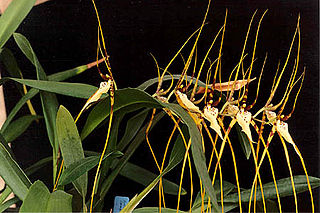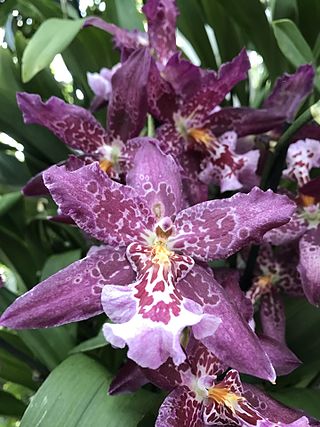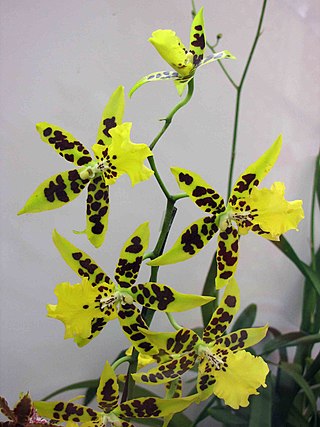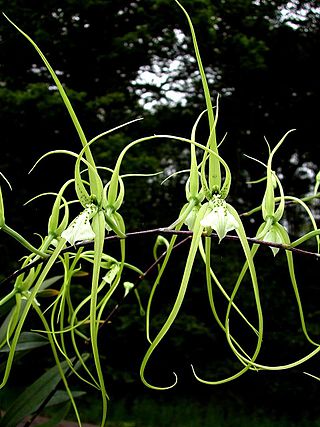
Brassia is a genus of orchids classified in the subtribe Oncidiinae. It is native to Mexico, Central America, the West Indies, and northern South America, with one species extending into Florida.

The Oncidiinae is a subtribe within the Orchidaceae that consists of a number of genera that are closely related.

Miltonia, abbreviated Milt. in the horticultural trade, is an orchid genus comprising twelve epiphyte species and eight natural hybrids. The miltonias are exclusively inhabitants of Brazil, except for one species whose range extends from Brazil into the northeast of Argentina and the east of Paraguay.
Odontoglossum, first named in 1816 by Karl Sigismund Kunth, is a formerly accepted genus of orchids that is now regarded as a synonym of Oncidium. Several hundred species have previously been placed in Odontoglossum. The scientific name of the genus is derived from the Greek words odon (tooth) and glossa (tongue), referring to the two tooth-like calluses on the base of the lip. Species formerly placed in this genus are cool to cold growing orchids to be found on open spots in the humid cloud forest at higher elevations from Central- and West South America to Guyana, with most species around the northern Andes. The abbreviation for this genus is Odm. in the horticultural trade. Many of the species formerly placed in the genus are in great demand with orchid lovers because of their spectacular and flamboyant flowers.
Spider orchid typically refers to the orchid genus Caladenia as a whole.

× Aliceara, abbreviated Alcra. in the horticultural trade, is the nothogenus for intergeneric hybrids between three orchid genera. The name Cambria is used in the horticultural trade.

× Beallara, abbreviated Bllra. in the horticultural trade, is the nothogenus for intergeneric hybrids between the orchid genera Brassia, Cochlioda, Miltonia and Odontoglossum. As Cochlioda and Odontoglossum have been synonymized with Oncidium, the current genera involved are Brassia x Miltonia × Oncidium = × Aliceara.

× Brassidium, abbreviated in trade journals Brsdm, is an artificial intergeneric hybrid between the orchid genera Brassia and Oncidium. When Cochlioda and Odontoglossum are sunk into Oncidium, × Maclellanara (Mclna.), × Odontobrassia (Odbrs.) and × Sanderara (Sand.) are synonyms.

× Degarmoara, abbreviated Dgmra. in the horticultural trade, is the nothogenus comprising intergeneric hybrids between the orchid genera Brassia, Miltonia and Odontoglossum.

× Bratonia, abbreviated Brat. in the horticultural trade, is the nothogenus for intergeneric hybrids between the orchid genera Brassia and Miltonia. An incorrect synonym for this nothogenus is × Miltassia (Mtssa.).

Brassia verrucosa, also known as warty brassia, is a species of plant in the family Orchidaceae native to Mexico, Central America, Venezuela, and Brazil.

Brassia keiliana is a species of orchid. It is native to Colombia, Venezuela and Guyana.

Brassia arachnoidea is a species of orchid. It is endemic to the Rio de Janeiro region of Brazil.

Brassia arcuigera, the arching brassia, is a species of orchid. It is native to Honduras, Costa Rica, Panama, Colombia, Venezuela, Ecuador, and Peru. The subspecies B. a. longissima is most notable for its very large flowers; as much as 21 inches wide "tip to tip".

Brassia caudata is a species of orchid. It is found widespread across the warmer parts of the Western Hemisphere, reported from southern Mexico, Central America, southern Florida, Greater Antilles, Trinidad, northern South America. It is also known by the common names tailed Brassia, spider orchid and cricket orchid.

Brassia gireoudiana, or Gireoud's brassia, is a species of orchid. It is native to Costa Rica and Panama.

Brassia lanceana, or Lance's brassia, is a species of orchid. It is native to Trinidad & Tobago, Venezuela, Guyana, Suriname, French Guiana, Colombia, Panama, Ecuador, Peru and northern Brazil.

Brassia macrostachya is a species of orchid native to Venezuela and Guyana.

Brassia maculata, the spotted brassia, is a species of orchid. It is native to southern Mexico, Central America, Cuba, and Jamaica.

Brassia aurantiaca is a species of orchid. It is native to Colombia, Ecuador and Venezuela.
















